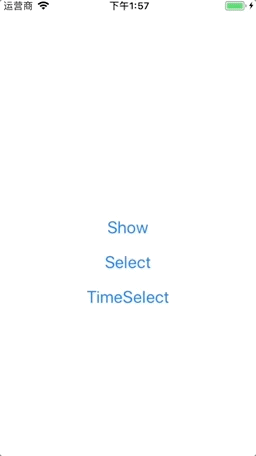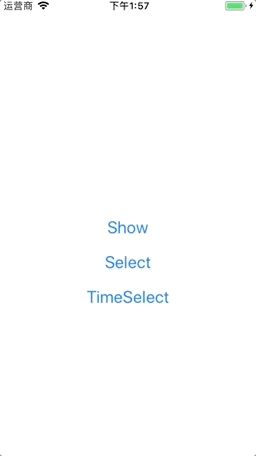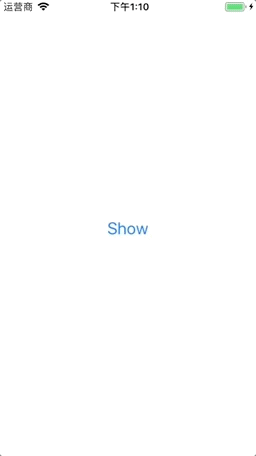用UIPresentationController来写一个简洁漂亮的底部弹出控件
iOS App开发过程中,底部弹出框是一个非常常见的需求。如何写一个漂亮的底部弹出框呢?方式有很多,直接添加一个自定义的View让它动画展示和隐藏都是一种非常简单的操作,不过看起来似乎不那么优雅,我们可以使用UIPresentationController来方便快捷地创建一个高定制化的底部弹出框。UIPresentationController的官方文档地址如下:
UIPresentationController: an object that manages the transition animations and the presentation of view controllers onscreen.
先上最终效果:


GitHub: github.com/IkeBanPC/Pr…
我们需要在iOS8及以上的系统中使用UIPresentationController,使用时需要新建一个类继承UIPresentationController并重写以下几个方法和属性:
//决定了弹出框的frame
override var frameOfPresentedViewInContainerView
//重写此方法可以在弹框即将显示时执行所需要的操作
override func presentationTransitionWillBegin()
//重写此方法可以在弹框显示完毕时执行所需要的操作
override func presentationTransitionDidEnd(_ completed: Bool)
//重写此方法可以在弹框即将消失时执行所需要的操作
override func dismissalTransitionWillBegin()
//重写此方法可以在弹框消失之后执行所需要的操作
override func dismissalTransitionDidEnd(_ completed: Bool)
重写初始化方法:
override init(presentedViewController: UIViewController, presenting presentingViewController: UIViewController?) {
super.init(presentedViewController:presentedViewController,presenting: presentingViewController)
}
在大多数时候,我们希望底部弹出框出现时,先前的显示区域能够灰暗一些,来强调弹出框的显示区域是用户当前操作的首要区域。因此,我们给这个自定义的类添加一个遮罩:
lazy var blackView: UIView = {
let view = UIView()
if let frame = self.containerView?.bounds {
view.frame = frame
}
view.backgroundColor = UIColor.black.withAlphaComponent(0.5)
return view
}()
重写presentationTransitionWillBegin、dismissalTransitionWillBegin和dismissalTransitionDidEnd(_ completed: Bool)方法。在弹窗即将出现时把遮罩添加到containerView,并通过动画将遮罩的alpha设置为1;在弹窗即将消失时通过动画将遮罩的alpha设置为0;在弹框消失之后将遮罩从containerView上移除:
override func presentationTransitionWillBegin() {
blackView.alpha = 0
containerView?.addSubview(blackLayerView)
UIView.animate(withDuration: 0.5) {
self.blackView.alpha = 1
}
}
override func dismissalTransitionWillBegin() {
UIView.animate(withDuration: 0.5) {
self.blackView.alpha = 0
}
}
override func dismissalTransitionDidEnd(_ completed: Bool) {
if completed {
blackView.removeFromSuperview()
}
}
接下来,我们重写frameOfPresentedViewInContainerView这个属性。它决定了弹出框在屏幕中的位置,由于我们是底部弹出框,我们设定一个弹出框的高度controllerHeight,即可得出弹出框的frame:
override var frameOfPresentedViewInContainerView: CGRect {
return CGRect(x: 0, y: UIScreen.main.bounds.height-controllerHeight, width: UIScreen.main.bounds.width, height: controllerHeight)
}
为了便于我们创建各种各样的底部弹出框,我们创建一个基类PresentBottomVC继承自UIViewController,并添加一个属性controllerHeight用于得到弹出框的高度:
public class PresentBottomVC: UIViewController {
public var controllerHeight: CGFloat? {
get {
return self.controllerHeight
}
}
}
之后,我们就可以新建继承自PresentBottomVC并重写controllerHeight属性的类来实现定制化底部弹出框。为了方便调用弹出方法,我们给UIViewController添加一个Extension,并实现UIViewControllerTransitioningDelegate协议:
public func presentBottom(_ vc: PresentBottomVC.Type) {
let controller = vc.init()
controller.modalPresentationStyle = .custom
controller.transitioningDelegate = self
self.present(controller, animated: true, completion: nil)
}
public func presentationController(forPresented presented: UIViewController, presenting: UIViewController?, source: UIViewController) -> UIPresentationController? {
let present = PresentBottom(presentedViewController: presented, presenting: presenting)
return present
}
可以看到,所有继承自PresentBottomVC的ViewController都可以通过该方法来从另一个ViewController的底部弹出。例如,我们新建一个类FirstBottomVC,重写controllerHeight并设为200,在页面中添加一个关闭按钮:
final class FirstBottomVC: PresentBottomVC {
lazy var closeButton:UIButton = {
let button = UIButton(frame: CGRect(x: 15, y: 30, width: 80, height: 30))
button.setTitle("Close", for: .normal)
button.setTitleColor(.black, for: .normal)
button.addTarget(self, action: #selector(closeButtonClicked), for: .touchUpInside)
return button
}()
override var controllerHeight: CGFloat? {
return 200
}
override func viewDidLoad() {
super.viewDidLoad()
view.backgroundColor = .cyan
view.addSubview(closeButton)
}
@objc func closeButtonClicked() {
self.dismiss(animated: true, completion: nil)
}
}
之后在需要弹出的时候调用UIViewController的presentBottom(_ vc: PresentBottomVC.Type)方法就可以一句代码搞定啦:
self.presentBottom(FirstBottomVC.self)
效果如下图:

测试用的弹框写好了,我们只要根据自己的需求去创建不同的PresentBottomVC的子类就可以方便快捷的实现各种各样的底部弹出框啦。实例中的两个效果可以参考GitHub源码